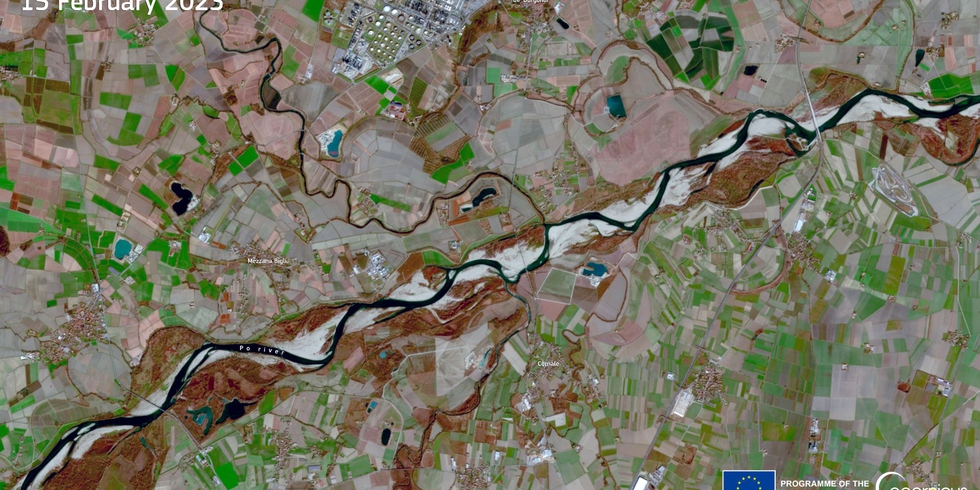The Po river basin, vital to part of Italy’s agriculture, is already in crisis: without rain in March or April, the drought will be worse than last year.
“I am from the Po valley and last year, in my area, between 30 and 50 per cent of crop harvests had to be thrown out. There is still great uncertainty about the coming summer but if it doesn’t start raining in March and April, the situation this summer will be even worse.” Roberto Perotti is the president of the Order of Geologists in Lombardy and his voice, at a time when a record drought is being reported for the time of year in the Po river region and Lake Garda, sounds worried.
The Po river runs dry
Alarm over drought in the Po valley, which caused considerable damage in the summer of 2022, is once again being raised. On the eve of the 2023 sowing season, the Po river is already running dry. At the Becca bridge in Pavia province, the level has fallen to -3.3 metres compared to the chart datum, with the riverbanks transformed into sandy beaches as happened last summer. The situation in Italy’s longest river is representative of the difficulties faced by all other water courses in the north of the country, with the great lakes in the region seeing their fill percentage drop to 39 per cent for Lake Garda and Lake Maggiore and 21 per cent for Lake Como. Furthermore, the amount of water stored as snow in the Alps and Apennines is also very low. Water deficits are being felt throughout northern Italy, primarily in Piedmont and Lombardy but also in Veneto and Trentino. The gap in Emilia-Romagna, meanwhile, is slightly less pronounced than last year thanks to recent rains and some snowfall which helped restore the flow in Apennine water courses, increasing flows to the Po.
There have also been some consequences that may appear superficially “pleasant”. The island of San Biagio, in Manerba on Lake Garda, can, incredibly, now be reached on foot. Though this may be a charming experience for the many visitors, it is primarily a dramatic manifestation of the water emergency in this winter of 2022-23. The island is normally reached via a ferry or by fording a small isthmus where the water reaches one’s thighs or waist. However, at the moment, the prolonged absence of rain and lack of snow on the mountains have caused the water level on Lake Garda to fall below the seasonal average by over 50 centimetres, thus allowing everyone to reach the island simply by walking there.
Even in terms of temperatures, there was a 1-1.5°C general increase in January. Snowfall, meanwhile, though present unlike last year, was still lower than average in the Alps and thus insufficient to provide continuous flow into artificial reservoirs for the production of hydroelectricity.
Saltwater in wells
Finally, there are concerns in the Po Delta over saltwater intrusion (or salt wedge), which – according to the Basin Authority’s bulletin, could increase if the flow of water in the river were to fall further. “This means that, if the water table that feeds the river were to fall, saltwater from the sea will tend to advance inland without the contrasting action of the mass of freshwater. This will create a salt wedge, causing wells near the delta to supply saltwater rather than freshwater, which will be a problem for agriculture.”
After the 18 sessions organised in a state of continuous water emergency last year, the Permanent Observatory on Water Use of the Po River District Basin Authority met for the first time in 2023 on 9 February. The body includes the regions along the river’s course and their monitoring agencies (ISPRA) as well as all the stakeholders in the Po valley that are involved in water resource management. However, according to Roberto Perotti, the problems are on two levels. The first is that there should have been better preparedness for 2023. “The events in recent years should have already put us in the position to proceed with structural interventions, which instead will almost certainly be insufficient.”
The other is that within the Observatory, “a huge amount of data are presented by different stakeholders which can often be difficult to coordinate. For example, there are energy producers who require water to flow downstream to produce hydroelectricity, which, however, empties out reservoirs upstream. In essence, it is a data collection observatory that lacks decision-making and operational powers.” Generally, the body only intervenes, via the Civil Protection agency, “when the point of no return has been reached and everyone has to come to an agreement.”
In actuality, the projects do exist. Funds from the National Recovery and Resilience Plan allocate 3.2 billion euros for the creation of 10,000 basins by 2030, “but as of now, only 233 projects have started and only 2 per cent have been completed”. This is due to structural problems and the long waits required to locate suitable sites, at times also because it becomes necessary to carry out the compulsory purchase of land that, despite its suitability, is used in agriculture. However, these collection basins and reservoirs would also be necessary “because, after long periods of drought, so-called spot events occur in very concentrated areas and there might be valleys with lots of water and others with none. In these cases, reservoirs could help act as a buffer.”
Siamo anche su WhatsApp.
Segui il canale ufficiale LifeGate per restare aggiornata, aggiornato sulle ultime notizie e sulle nostre attività.

Quest'opera è distribuita con Licenza Creative Commons Attribuzione - Non commerciale - Non opere derivate 4.0 Internazionale.









